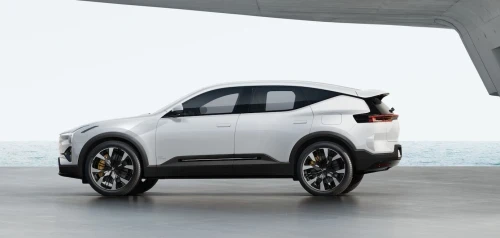The total cradle-to-gate carbon footprint of Polestar’s first electric performance SUV, Polestar 3, is lower than that of the smaller Polestar 2 when it was launched in 2020 at 24.7 tCO2e versus 26.1 tCO2e.

The majority of greenhouse gas (GHG) emissions stem from the extraction and processing of various materials for three components: aluminum, steel, and batteries. The Lifecycle Assessment (LCA) report for Polestar 3 shows that material production and refining contribute 68% of its cradle-to-gate carbon footprint of which aluminum represents 24%, iron and steel 17% and battery module production 24%.
Polestar aims to implement existing solutions, advocate for emerging solutions, and actively address what is currently considered unsolvable. Existing solutions may involve purchasing aluminum produced using renewable electricity, emerging solutions could include steel made with renewable energy, and entirely new solutions may relate to electronics, tires, and thermoplastics.
The approach to meeting the ambitious cradle-to-gate target for Polestar 3 took learnings from the carbon footprint reductions of Polestar 2. Consequently, 81% of Polestar 3’s total aluminum mass production, the Li-ion battery cell module production as well as anode and cathode material production use 100% renewable electricity. By doing this, 8.5 tCO2e have been eliminated.

Manufactured initially at Volvo Cars’ Chengdu factory in China, additional production is slated to start in South Carolina in the middle of 2024. Both manufacturing plants use 100% renewable electricity. A separate LCA will be produced for cars produced in this factory.
The majority of a vehicle’s greenhouse gas emissions stem from extracting and processing materials. As we accelerate the adoption of electric cars, there is a lot we can do to reduce their production-related emissions and strengthen the role of innovations and of electric cars as a climate solution, Polestar 3 is a testament to that.
—Fredrika Klarén, Head of Sustainability at Polestar
Comprehensive transparency about the environmental impact of the car is offered by the LCA report. The LCA has been calculated using three different electricity mixes and a 200,000 km lifetime distance driven. The methodology to assess the electricity in use phase has been updated and now includes more realistic scenarios from the IEA (International Energy Agency) which take into account increased shares of renewables, underscoring their potential for reducing the car’s emissions during the use phase.
For the first time in any Polestar LCA, vehicle maintenance is included in the calculations. The car’s cradle-to-grave carbon footprint ranges between 28.5 – 44.5 tCO2e depending on the electricity used to charge the vehicle during its lifetime.
The LCA report, conducted in accordance with ISO 14067:2018, is the first Polestar LCA report that has been reviewed by a third party, the global strategic, environmental, and engineering consultancy Ricardo plc.
Source from Green Car Congress
Disclaimer: The information set forth above is provided by greencarcongress.com independently of Alibaba.com. Alibaba.com makes no representation and warranties as to the quality and reliability of the seller and products.




